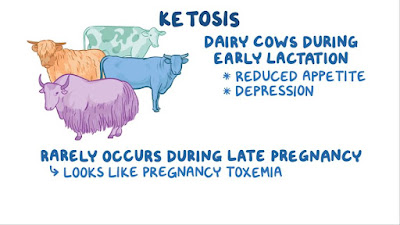Ketosis (acetonaemia) disease in dairy cattle
Ketosis, or acetonaemia, is a metabolic disorder in cattle associated with an inadequate supply of the nutrients necessary for the normal carbohydrate and fat metabolism that is seen mainly in times of high milk production in early lactation.
During early lactation, the energy intake is insufficient to meet the energy output in milk and the animal is in a negative energy balance.
 |
| ketosis in dairy cow |
Hypoglycemia (low blood sugar) is the major factor involved in the onset and development of clinical signs of
ketosis. Ketosis affects high producing cows during the first 6-8 weeks of lactation when cows are in negative energy balance.
Ketosis occurs when energy intake fails to meet the requirements for high glucose production, necessary for mainte-nance and milk lactose production.
The excessive ketone bodies in the bloodstream come from the breakdown of fat when the animal is forced to draw on its bodily reserves for energy. Although the metabolism of body fat provides energy for cows, the nervous system is dependent
on glucose, and the ketones produced as a result of excessive fat metabolism can have toxic effects. The excess ketone bodies are eliminated in the urine, milk and breath of the animal.
Predisposing factors
Cows of any age may be affected but the disease appears more common in later lactations peaking at about the 4th lactation. Over conditioning at calving has been associated with increased incidence of ketosis.
A reduction in the production of propionic acid, the main precursor of glucose in ruminants, will result in hypoglycaemia.
Hypoglycaemia leads to a mobilization of free fatty acids and glycerol from the fat stores. The reduction of propionic acid
production is usually the result of underfeeding or a reduced feed intake caused by in-appetence. The in-appetence may be caused by poor feed quality, sudden changes in diet or excessive fatness at calving.
Clinical signs of Ketosis
In many cases of ketosis, the disease is sub-clinical, with the cow’s performance and health compromised, but without obvious clinical signs. The clinical signs of ketosis include lack of appetite (refusal to eat even concentrates) and a sudden
drop in milk output. There is a sweet smell of acetone in the urine, breath and milk.
Cows will have raised blood ketone levels and may excrete ketones in urine and milk. There is a gradual loss of body condition over several days or even weeks.
Prevention of Ketosis
Ketosis causes financial loss through lost production and treatment. It may be prevented by management strategies that maintain a good appetite and supply adequate feed to meet this appetite during the late dry period and immediately after
calving.
These strategies include;
i. Avoid sudden changes in feed type to newly calved animals
ii. Ensure cows in body condition 4.0 or less prior to calving.
iii. Ensure that any health problems that may cause reduced feed intake are treated as early as possible.
Tags:
Dairy Farming
